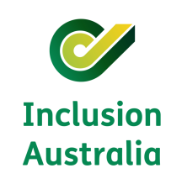What is customised employment?
Customised employment is part of a suite of approaches that provide supports to job seekers with disability, and has been particularly designed for people with significant disability (Wehman et al. 2018). Customised employment was developed in 2001 in the United States by the U.S. Department of Labor’s Office of Disability Employment Policy and has been used widely in the US since then and extended to other parts of the world (Wehman et al. 2018).
Unlike traditional approaches to getting a job in the competitive labour market, it does not begin by focusing on job vacancies but focuses on what the person with disability has to offer the labour market (LEAD Center, 2015). Customised employment is targeted and pro-active and works with both the job seeker and the employer to shape a job opportunity and a create a specific job description to match the requirements of both (Wehman et al. 2018; Citron et al. 2008). It involves:
a well-defined discovery process … identifying the individual’s strengths, interests, and preferences. The outcome of that process then drives the identification of employment opportunities where unique job descriptions are created that match both the employer’s and employee’s needs and interests (Wehman et al., 2018, p.134).
Customised employment can include a range of strategies such as:
Job carving: Crafting a job out of some elements or tasks of a job description, but not all.
Job negotiation: Combining tasks from multiple job descriptions within a business into a new job description.
Job creation: A new job description is created from unmet business needs identified during discussions with the employer (usually led by an employment specialist).
Job sharing: Two or more people sharing the same job.
Self-employment: Creation and operation of a self-owned business (or microenterprise) with or without the help of paid (e.g., service agencies) or unpaid (e.g., family members) support. (Adapted from Wehman et al., 2018, p. 135 and Citron et al., 2008, p.170).
Researchers from the United States explain that customized employment importantly focuses on delivering a “win-win” for both employee and employer:
Customized employment opportunities by definition are successful because there is a specific match between the employer’s needs and the strengths, preferences, interests, talents, and what works/doesn’t work for the individual with a disability that the employer can, as part of his/her day-to-day business practices or with minimal reasonable accommodations, provide (Ouimette and Rammler 2017, p.334).
Common ingredients include:
- The job-seeker’s interests, preferences, and talents drive the employment development process, not the labour market;
- A negotiation of mutual benefit between the job-seeker and the employer;
- The provision of long-term workplace supports, such as workplace training and support, that are not time limited;
- Long-term supports are tailored to the needs of the person and to the employer to ensure ongoing employment is maintained (Inge et al., 2018; King & Waghorn, 2018; Luecking & Luecking, 2006; Riesen et al., 2015; Smith, McVilly, Rhodes, & Pavlidis, 2018; U.S. Department of Labor, 2011; Wehman et al., 2018).
Customised employment is typically a lengthy process to build an understanding of the individual with disability and to build an appropriately matched job with an employer. Overall, the customized employment process is resource intensive. One US study found that the mean duration from commencement of the customized employment process (at step 1 Discovery) to job placement was 128 days (range = 11 to 374 days) (Luecking and Luecking, 2006), a time parameter broadly confirmed by other studies in the US context.
Steps in the customized employment process
The customized employment process relies on the support of a professional employment specialist who guides and resources the steps of the process.
Step 1: ‘Discovery’ process:
The Discovery process is a ‘person-centered exploration of an individual’s strengths, preferences, interests, and needs’ (Wehman et al. 2018, p.134). This might involve vocational assessments as well as discussions with the person, their family and friends (Wehman et al. 2018). The Discovery process:
guides job seekers through a process of finding out who they are, what they want to do, and what they have to offer … [it] collects information about the job seeker’s interests, skills, environmental preferences, employment goals, and other topics related to the job seeker’s employment search, rather than outlining their deficits (LEAD Center, 2015, p. 5).
Smith, McVilly, McGillivray et al. (2018) highlight that the Discovery process also
identifies and highlights the existing social capital the client can draw upon to make their employment dream a reality, or identifies where such social capital needs to be built as a first step towards realising their ambitions (p. 71).
Smith, McVilly, McGillivray et al. (2018) argue that this focus on illuminating the social capital (information and networks) around the person with disability is a critical additional feature of the Discovery process that enables the link into employment by unlocking the supports and information that exist around the person.
The ‘Discovery’ process has been used since the mid 1980’s and so has significant practice resources available to support it. The Discovery process typically involves:
- Meet, plan with and observe the job seeker over a period of time and in different locations/settings/environments. Physically meeting with the person in familiar and unfamiliar environments enables observation of the person’s capacities in use and the resources available to them. The process involves attending to what are the person’s goals for employment and, because many people have not had the life experience to develop these, also attending to their likes and dislikes;
- Interview family, friends and other acquaintances to bring out interests and needs;
- Synthesize observations about the job seeker at home and in the community; most importantly through a discussion with the job seeker. Observation of the person in a range of settings, for example doing volunteer work, in leisure activities, at home, in day services or ADEs, in religious or cultural activities helps identify interests, particularly where a person is unable to verbalise these;
- With the job seeker, identify his/her interests and the businesses in the community that are most strongly aligned with these interests. This might include organizing visits to potential businesses to give the job seeker a concrete experience of the work environment and the type of work proposed. In addition, this step is likely to involve having ‘informational interviews’ (Inge et al. 2018) with employers to learn more about the types of jobs and the industry in order to help shape the thinking about the relevant task mix or the suitability of the match;
- Identify the contributions the job seeker has to offer to a business. This should include observing the job seeker actually undertaking work-related tasks either at home, in a different setting or as part of a set of short negotiated work experience opportunities that might focus on discrete aspects of a job, so as to build up a picture of what is the best match;
- Identify the essential versus desirable conditions that will help the job seeker thrive in an employment situation (Adapted from LEAD Center, 2015, p.6; Inge et al. 2018).
The process typically takes between 20-60 hours, but averages 30 (Smith, McVilly, McGillivray et al. 2018). The output of the Discovery process is a ‘vocational profile’ which describes the individual job seeker, their vocational area or theme, and ‘ideal working conditions for the individual’ (Riesen et al. 2015, p.187). The profile can include pictures of the job seeker performing tasks in a variety of settings (Brown, 2009). This profile is checked by the job seeker and their supporters (Inge et al. 2018; Brown, 2009). The profile is used as a basis for a customized planning meeting with the person and supporters (Brown, 2009). Finally, in some models, such as the Individualised Career Planning model (Brown, 2009), a ‘Representational Portfolio’ is produced which is designed to be used with prospective employers. The portfolio contains information about the customized employment approach, explaining the ‘win-win’ principle underpinning it, as well as information about the job-seeker ‘using pictures and text to graphically describe his interests, contributions, and successful support strategies, as well as the specific job tasks he can perform. These tasks become the building blocks of a customized job’ (Brown, 2009, p. 99).
Step 2: Finding and negotiation with employer
Employers identified through the Discovery process as being a potential match for the job seeker are approached (Brown, 2009). Negotiation with a potential employer focuses on satisfying ‘an existing need through development of a new (and customized) role’ (Wehman et al. 2018, p.135). This includes working directly with the employer to:
- customise a job description based on current employer needs or on previously unidentified and unmet employer needs;
- develop a set of job duties
- develop a work schedule
- develop the job arrangement, along with specifics of supervision (including performance evaluation review),
- determine the job location (Riesen et al. 2015, p. 184).
Each position is ‘customised’ through a person-centred, rather than an employer-centred, lens which also seeks to identify how the job seeker can contribute to the business by meeting unmet needs. This involves a detailed process of discussion and negotiation, and uncovering of employer needs, not simply placement into existing positions (Inge et al. 2018).
Step 3: Customised supports
Identification of the customized supports needed occurs prior to job commencement. Customized supports and reasonable accommodations are provided in a non time-limited way (Griffin-Hammis Associated, n.d.). These can include informal supports (for example support with transport and independent living skills) as well as formal supports such job coaching, or personal care supports (Smith, McVilly, McGillivray et al. 2018; Brown, 2009).
Step 4: Provision of on-the-job training
Customised supports also include on-the-job and formal training matched to the person’s needs (Wehman et al. 2018).
Outcomes
Highly individualised approaches, such as customised employment, are designed to address and overcome the barriers that people with disability experience and that are created by the way work is structured (Becker, Flack, & Wickham, 2012; Bond, Drake, & Becker, 2008; Condon & Callahan, 2008; Inge, Graham, Brooks-Lane, Wehman, & Griffin, 2018; Riesen, Morgan, & Griffin, 2015; Smith, Atmatzidis, Capogreco, Lloyd-Randolfi, & Seman, 2017; U.S. Department of Labor, 2011). It is argued that:
Customized employment has the potential for minimizing competition with other job seekers without disabilities, since the outcome is a negotiated job description for a specific job seeker with a disability (Inge et al. 2018, p.165).
There is an emerging evidence base showing that customized employment is successful (Wehman et al. 2018). A review of evidence by Riesen et al. (2015) identifies a range of projects that have used customised employment for significant numbers of people with intellectual disability to obtain (or create) employment in the open labour market, including through self employment. Inge et al. (2018) report that different projects have achieved between a 45-71% employment rate in open employment with high levels of job retention after 1 year. A study of young people with Autism Spectrum Disorder and intellectual disability in the US found that customized employment was similarly successful with this group. Importantly, researchers noted that of the jobs gained, the large majority required significant customization to create job descriptions, reassign tasks and provide modifications (Inge et al. 2018, citing Wehman et al. 2016). Research in the US has verified that customized employment has also been shown to:
- increase quality of life outcomes (Riesen et a. 2015)
- deliver wage increases (Riesen et a. 2015).
The individualised and customized approach has been noted to ‘have been successfully implemented with many …youth and adults who had been labeled “too disabled to work”’ (Brown, 2009, p.101).
References
Becker, A., Flack, L., & Wickham, C. (2012). Programs That Support Employment for People With Severe Mental Illness: A Literature Review International Journal of Psychosocial Rehabilitation., 16(1), 52-58.
Bond, G. R., Drake, R. E., & Becker, D. R. (2008). An update on randomized controlled trials of evidence-based supported employment. Psychiatric Rehabilitation Journal, 31, 280-290.
Brown, K. (2009) Connecting Youth and Communities: Customized Career Planning for Youth with Psychiatric Disabilities, The Journal of Sociology & Social Welfare: Vol. 36 , Iss. 4 , Article 7. Available at: https://scholarworks.wmich.edu/jssw/vol36/iss4/7
Citron, T.; Brooks-Lane, N.; Crandell, D.; Brady, K.; Cooper, M. and Revell, G. (2008). A revolution in the employment process of individuals with disabilities: Customized employment as the catalyst for system change, Journal of Vocational Rehabilitation 28, 169–179.
Condon, E., & Callahan, M. (2008). Individualized Career Planning for students with significant support needs utilizing the Discovery and Vocational Profile process, cross-agency collaborative funding and Social Security Work Incentives. Journal of Vocational Rehabilitation, 28(2), 85-96.
Griffin-Hammis Associates. (n.d.). Customized Employment. from http://www.griffinhammis.com/customizedemployment.html
Hall, A.; Butterworth, J.; Winsor, J.; Kramer, J.; Nye-Lengerman, K. and Timmons, J. (2018). Building an Evidence-Based, Holistic Approach to Advancing Integrated Employment, Research and Practice for Persons with Severe Disabilities, Vol. 43(3) 207–218.
Inge, K., Graham, C., Brooks-Lane, N., Wehman, P., & Griffin, C. (2018). Defining customized employment as an evidence-based practice: The results of a focus group study. Journal of Vocational Rehabilitation, 48(2), 155-166. doi: 10.3233/JVR-180928
King, J., & Waghorn, G. (2018). How Higher Performing Employment Specialists Support Job-seekers with Psychiatric Disabilities Retain Employment. The Journal of Rehabilitation(4), 22.
LEAD Center, (2015). Frequently Asked Questions: Using Customized Employment’s Discovery and Group Discovery Models to Promote Job Seeker Success in American Job Centers, http://www.leadcenter.org/system/files/resource/downloadable_version/CE-and-Group-Discovery-FAQs.pdf
Luecking, D. M., & Luecking, R. G. (2006). A Descriptive Study of Customizing the Employment Process for Job Seekers with Significant Disabilities. Journal of Applied Rehabilitation Counseling, 37(4), 14-21.
Ouimette, M. and Rammler, L. (2017) Entrepreneurship as a means to employment first: How can it work? Journal of Vocational Rehabilitation 46, 333–339.
Riesen, T., Morgan, R. L., & Griffin, C. (2015). Customized employment: A review of the literature Journal of Vocational Rehabilitation, 43(3), 183-193. doi: 10.3233/JVR-150768
Smith, D., Atmatzidis, K., Capogreco, M., Lloyd-Randolfi, D., & Seman, V. (2017). Evidence-Based Interventions for Increasing Work Participation for Persons With Various Disabilities. OTJR: Occupation, Participation & Health, 37, 3S-13S.
Smith, P., McVilly, K., McGillivray, J., & Chan, J. (2018). Developing open employment outcomes for people with an intellectual disability utilising a social enterprise framework from https://www.researchgate.net/publication/323434591_Developing_open_employment_outcomes_for_people_with_an_intellectual_disability_utilising_a_Social_Enterprise_Framework
Smith, P., McVilly, K., Rhodes, P., & Pavlidis, L. (2018b). Customised Employment: building workforce capacity for and establishing an evidence-based means of achieving the social and economic participation of people with disability. Final Report to the Innovative Workforce Fund.
U.S. Department of Labor, O. o. D. E. P. O. (2011). Customized Employment Competency Model. from https://www.dol.gov/odep/pdf/2011cecm.pdf
Wehman, P., Taylor, J., Brooke, V., Avellone, L., Whittenburg, H., Ham, W., . . . Carr, S. (2018). Toward Competitive Employment for Persons with Intellectual and Developmental Disabilities: What Progress Have We Made and Where Do We Need to Go. Research and Practice for Persons with Severe Disabilities, 43(3), 131-144. doi: 10.1177/1540796918777730
The authors would like to acknowledge the usefulness of Crosbie, J.: Murfitt, K.; Hayward, S. & Wilson, E. (2019), NDIS Participant Employment Taskforce. Literature review: Employment and economic participation of people with disability, Burwood, Deakin University, as a review of similar literature that provided initial guidance.


